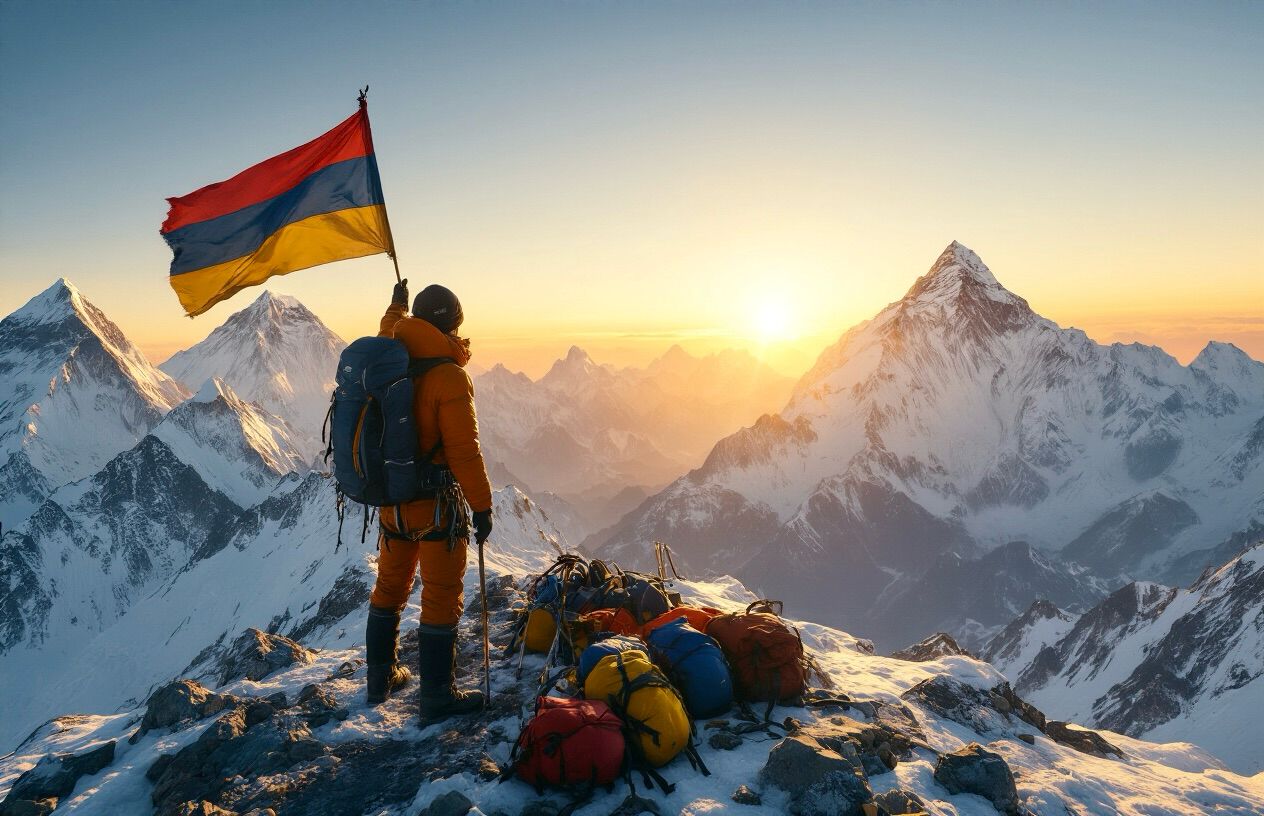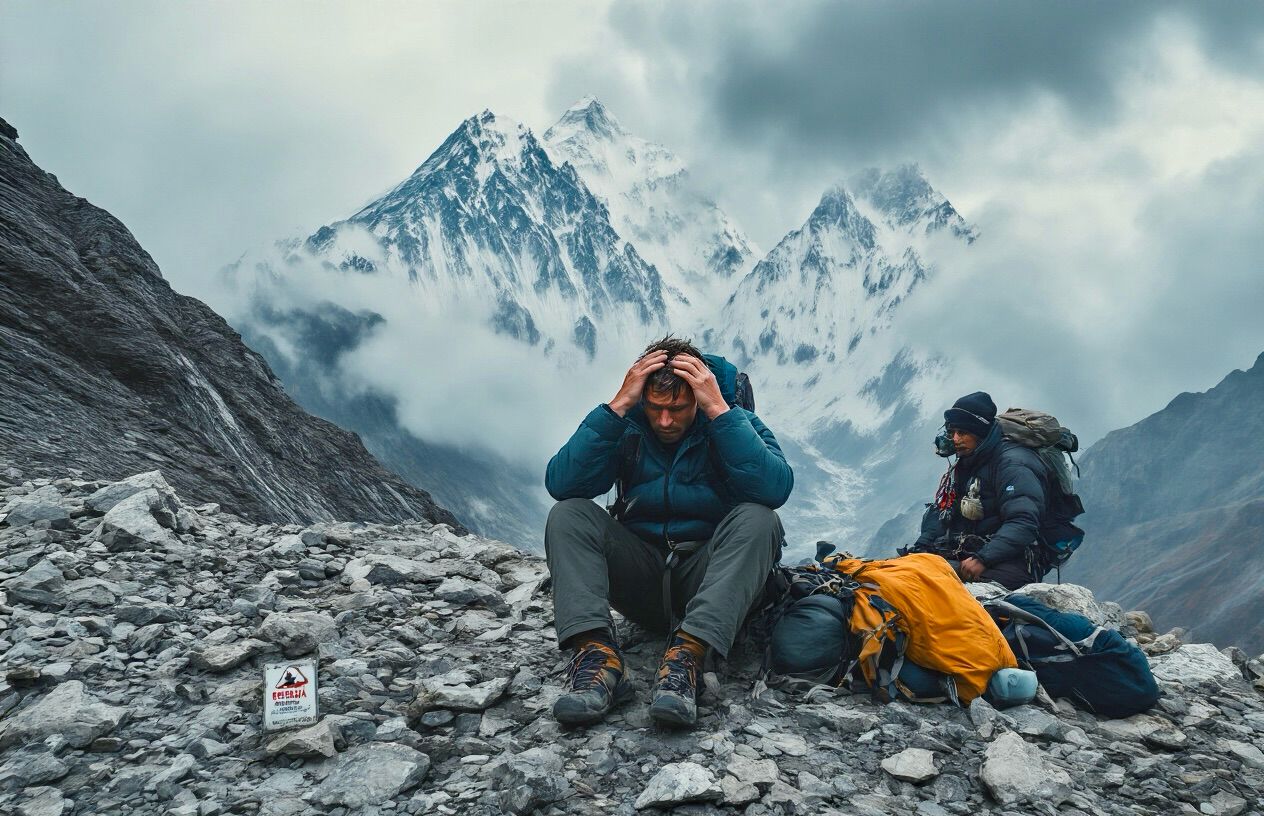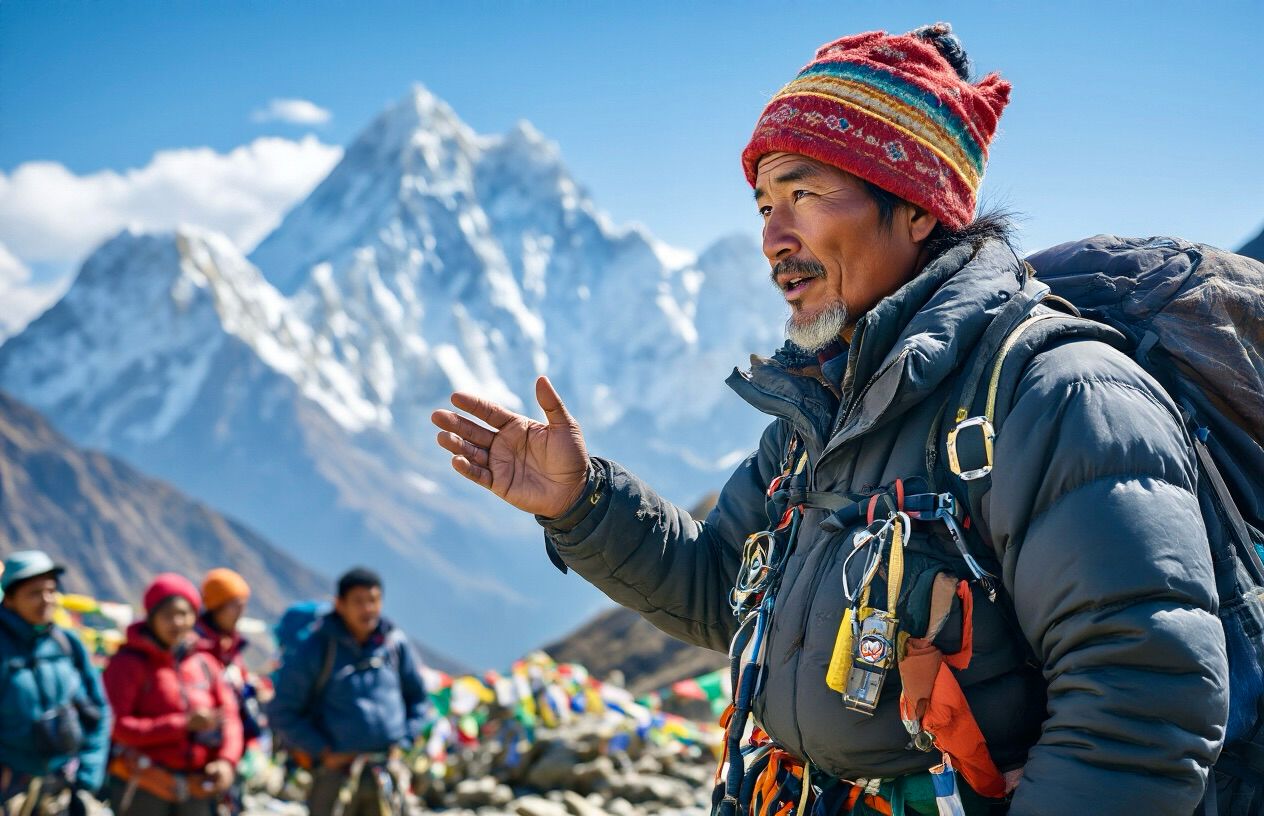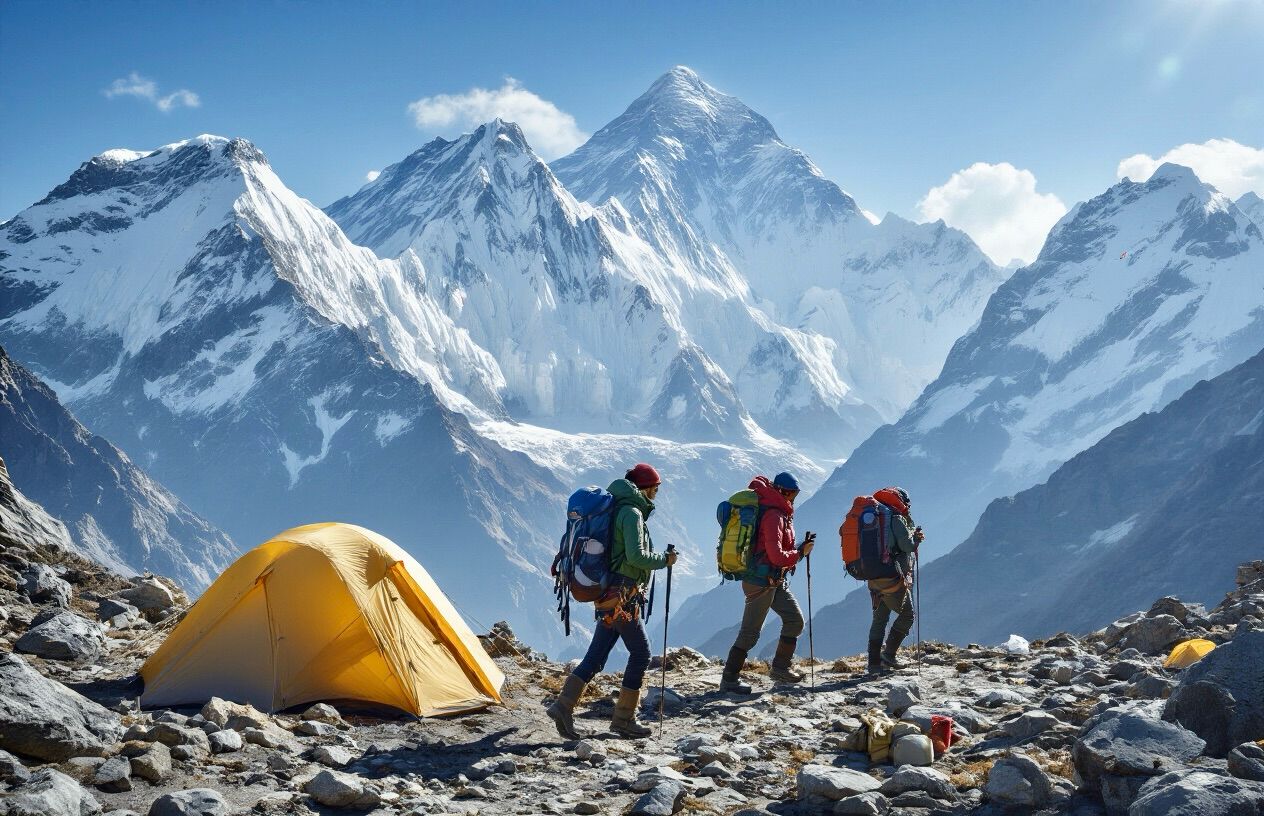Island Peak (6,189m) stands as one of Nepal's most popular climbing destinations for adventurers seeking their first Himalayan summit experience. While more accessible than the 8,000 m giants, this "island in a sea of ice" presents serious challenges that test even the most experienced mountaineers.
This guide from Everest Sherpa Expeditions is designed for aspiring climbers looking to summit Island Peak successfully. We'll walk you through the major obstacles you'll face and provide practical strategies to overcome them.
In this comprehensive guide, you'll learn about:
- Tackling the steep headwall with its 40-50 degree slopes and technical sections
- Managing altitude-related challenges at 6000+ meters, where oxygen levels drop dramatically
- Essential physical and mental preparation is needed for the grueling 12-16-hour summit day
Whether you're planning your first Himalayan climb or adding Island Peak to your mountaineering resume, understanding these challenges beforehand will significantly increase your chances of standing on that coveted summit.
Understanding Island Peak's Unique Climbing Challenges
Location and Route Complexity in the Everest Region
Island Peak, also known as Imja Tse, stands majestically at 6,189 meters in the heart of the Everest region. This remarkable peak earned its name because it appears as an island in a vast ocean of ice when viewed from Dingboche. As an extension of the mighty Lhotse and Everest mountains, Island Peak is situated in the distinctive mountain valley of Imja, surrounded by pristine glaciers flowing down from 8000-meter peaks.
The journey to Island Peak base camp at 5,100 meters presents significant challenges in itself. Climbers often follow the Everest Base Camp route before diverging toward Island Peak, navigating through rough terrains at elevations exceeding 5000 meters before even beginning the actual climb.

Extreme Weather Conditions and Temperature Fluctuations
The Everest region is notorious for its highly unpredictable weather patterns, creating a formidable obstacle for Island Peak climbers. Temperature fluctuations are extreme, ranging from a relatively mild 20 degrees Celsius to a bone-chilling -20 degrees Celsius, demanding exceptional preparation and adaptability.
During the prime climbing seasons of spring (April-May) and autumn (September-October), daytime temperatures typically range between 0 to 15 degrees Celsius. However, nights become significantly colder, with temperatures plummeting to between -5 and -10 degrees Celsius. These dramatic daily temperature swings require climbers to be prepared with appropriate layering systems and gear.
Beyond temperature challenges, climbers must contend with harsh sun exposure intensified by reflection from snow-capped mountains, as well as strong winds that can dramatically increase the perceived cold and create dangerous climbing conditions.
Technical Difficulty Level and Skill Requirements
Island Peak climbing is classified as extremely challenging, requiring substantial technical skills and physical conditioning. The climb's difficulty is compounded by the physically strenuous trek that precedes it, with climbers already fatigued before reaching the technical sections.
The most challenging part of the climb is the headwall, a formidable 300-meter ascent with a steep 40 to 50-degree slope located just before the summit ridge. This section demands proper rope skills, ice axe proficiency, and crampon technique.
The summit day itself is a test of endurance, typically lasting between 12 to 16 hours depending on conditions. Climbers must navigate steep, rocky paths, traverse glacier sections with potential crevasses, and use fixed ropes on the steepest portions. This combination of altitude, technical difficulty, and endurance requirements makes Island Peak a serious mountaineering challenge that demands proper training, equipment, and mental preparation.
Conquering Altitude-Related Obstacles
Managing Altitude Sickness and Proper Acclimatization Strategies

Island Peak stands at over 6000m, placing climbers in an environment where oxygen levels and air pressure are significantly lower than what most are accustomed to. This dramatic change presents one of the most formidable challenges: altitude sickness. The key to overcoming this obstacle lies in proper acclimatization.
For effective acclimatization, climbers should gain approximately 300m (1000 feet) in elevation per day. This gradual ascent allows your body to adapt to the decreasing oxygen levels. Spending extended time in the Himalayas also significantly improves your ability to acclimate to the challenging weather and climatic conditions.
Medication can serve as a supplementary aid in your acclimatization strategy. Diamox (Acetazolamide) is commonly used to help prevent altitude sickness, but should only be taken with a doctor's prescription. Equally important is maintaining proper hydration at all times, as this helps mitigate altitude sickness symptoms.
Strategic Acclimatization Points Along the Route
The journey to Island Peak offers several crucial stopping points that serve as ideal acclimatization stations:
- Namche Bazaar (3,500m): The first major acclimatization point, allowing climbers to begin adapting to higher elevations
- Dingboche (4,410m): A critical mid-point for further acclimatization before the final push
- Island Peak Base Camp (5,100m): The final acclimatization point before summit attempts
Many experienced climbers recommend taking the Everest Base Camp (5,364m) and Kala Pattar (5,545m) route before attempting Island Peak. This extended journey provides additional time for acclimatization, significantly increasing your chances of summit success.
Recognizing and Responding to Altitude Sickness Symptoms
Identifying the symptoms of altitude sickness early is vital for a safe climbing experience. If you begin to feel unwell or notice worsening symptoms while ascending, it's crucial to halt your climb immediately. Remember that continuing to ascend when experiencing altitude sickness can be fatal.
The golden rule when dealing with altitude-related issues is simple but potentially life-saving: if symptoms appear or worsen, do not continue ascending. Instead, descend to a lower elevation immediately. No summit is worth risking your life, and altitude sickness can escalate rapidly from uncomfortable to life-threatening if proper precautions aren't taken.
Mastering the Technical Climbing Sections
Navigating the Challenging Headwall and Summit Ridge
The headwall presents one of the most formidable challenges on Island Peak, particularly at its base, where the combination of steep incline and thin air tests even experienced climbers. This section is made significantly safer through the use of fixed lines installed by Sherpas. The final steep section before reaching the summit ridge involves a demanding 300-meter climb with slopes ranging between 40 and 50 degrees. Climbers must maintain focus and proper technique throughout this section, as the combination of altitude and steepness can quickly drain energy reserves.
Glacier Travel and Crevasse Crossing Techniques
After reaching the glacier field, proper safety protocols require climbers to rope up and don essential gear, including crampons. Navigation across this terrain involves crossing several crevasses, with some particularly challenging sections equipped with ladders to facilitate safer passage. Mastering the use of crampons and ice axes becomes critical here, as these tools are essential for maintaining stability on glacial terrain and safely navigating around or across the deep cracks in the ice. Proper weight distribution and foot placement techniques while wearing crampons can make the difference between confident progress and dangerous slips.
Fixed Rope Climbing and Abseiling Skills
The steep headwall section relies heavily on fixed lines, with Sherpas assisting by roping climbers up during the ascent. However, personal technical skills remain crucial for safety and efficiency. Abseiling (rappelling) down the headwall at 6,150 meters using a figure-8 device is a required skill that all climbers must master before attempting Island Peak. To ensure full control during descent, climbers should be thoroughly comfortable with abseiling techniques and practice transitioning between ropes using the figure-8 device.
Additionally, proficiency in essential climbing knots is non-negotiable for technical sections. In particular, knowing how to tie overhand knots and Italian hitch knots properly can prove crucial during various technical climbing scenarios encountered on Island Peak. These rope skills complement the climbing techniques needed to safely navigate the mountain's most challenging sections.
Essential Physical and Mental Preparation
Comprehensive Training Regimen for Strength and Endurance
Conquering Island Peak demands exceptional physical conditioning. A rigorous 4-5 month training program is essential for all climbers, regardless of previous experience. The summit day alone requires 12-16 hours of sustained effort, making endurance training non-negotiable.
To properly prepare your body for this challenge, follow these specific guidelines:
- Commit to training 5 days per week for 4-5 months before your expedition
- Maintain a strict, balanced diet throughout your training period
- Focus on inclined treadmill workouts four days weekly to simulate uphill climbing
- Train with a 5kg/11lbs backpack to acclimate your body to carrying weight
- Monitor your heart rate, keeping it within the endurance zone during workouts
- Progressively increase training duration from 1-2 hours initially to 4 hours as you advance
- Schedule one extended endurance session weekly to build stamina
- Allow 1-2 rest days weekly for recovery
- Incrementally increase the carried weight each month
- Dedicate 6-12 hours to training weekly
- Incorporate weight training after two months of cardiovascular preparation
- Focus on developing quad, calf, and core strength, which are crucial for mountain climbing
Specific Skill Development for Technical Climbing
Beyond raw strength and endurance, Island Peak requires mastery of technical climbing skills. Familiarize yourself with:
- Abseiling techniques for controlled descents
- Ladder crossing methods for navigating crevasses
- Rope management and safety protocols
- Proper use of the Jumar ascender for climbing fixed ropes
- Figure-8 descender techniques on fixed lines
These technical skills aren't just helpful—they're essential for safely navigating the mountain's challenging sections. Practice these techniques repeatedly until they become second nature.
Mental Fortitude and Psychological Readiness
The mental challenges of Island Peak can be as formidable as the physical ones. Developing psychological resilience is crucial for summit success. To build mental fortitude:
- Resolve any doubts or uncertainties before beginning your climb
- Develop strategies to manage fear and anxiety during difficult sections
- Practice visualization techniques to mentally rehearse challenging portions of the climb
- Incorporate mindfulness practices into your training regimen
- Use positive affirmations to maintain confidence
- Cultivate a positive attitude that can weather physical discomfort and unexpected challenges
Mental preparation transforms difficult moments from potential breaking points into manageable challenges. The climbers who summit Island Peak successfully are those who combine physical readiness with unwavering mental resilience.
Critical Gear and Equipment Selection

Essential Mountaineering Equipment and Safety Gear
The success and safety of your Island Peak expedition heavily depend on having the right mountaineering equipment. Fortunately, essential gear can be acquired in Chukhung near the base camp if you haven't brought your own. Your climbing kit must include sturdy, insulated climbing boots that are compatible with crampons. These boots serve as your foundation on the mountain and must provide adequate insulation against freezing temperatures.
Additionally, you'll need properly fitted crampons for traversing icy sections, an ice axe for stability and self-arrest, a figure 8 ascender for the fixed rope sections, and a harness that allows comfortable movement while providing security. A sleeping bag rated for extremely low temperatures is non-negotiable, as nighttime temperatures can drop dramatically at high altitude.
A comprehensive first aid kit is also essential equipment, particularly one that includes medication for altitude sickness, which is one of the most common challenges climbers face on Island Peak.
Proper Clothing Systems for Extreme Conditions
Island Peak's climate demands a strategic layering system to manage the extreme temperature variations you'll encounter during your climb. Your clothing system should consist of:
- Base layers that wick moisture away from your body
- Mid layers that provide insulation
- Outer shell layers that protect against wind and precipitation
This layering approach allows you to regulate your body temperature effectively as you move between different altitudes and weather conditions. The ability to add or remove layers quickly can prevent both overheating during strenuous climbing sections and dangerous cooling during rest periods.
Quality vs Rental Equipment Considerations
While rental equipment might seem like a convenient option, it's strongly recommended to purchase your own gear for the Island Peak climb. Rental equipment often suffers from quality issues that could compromise your safety and comfort during the expedition. Equipment that has been used by multiple climbers may show signs of wear that aren't immediately apparent but could fail under stress.
All climbing gear must fit you perfectly, as uncomfortable equipment can severely impact your climbing performance and overall experience. Ill-fitting boots can cause blisters or frostbite, a loose harness could fail to provide adequate protection during a fall, and improperly sized crampons might detach at critical moments. The investment in quality personal equipment pays dividends in safety, comfort, and climbing efficiency.
Strategic Planning and Risk Management
Optimal Timing and Weather Window Selection
When planning your Island Peak expedition, timing is crucial for success. The optimal climbing windows fall during the spring (March to May) and autumn (September to November) months when weather conditions are relatively stable. These seasons offer the best balance of temperature, precipitation, and visibility for a safe ascent.
It's strongly advised to avoid climbing between December and mid-February due to extreme weather conditions. During this period, heavy snowfall is common, and the summit can experience temperatures plummeting to around -40°C accompanied by harsh, chilly winds. Similarly, the February to March period can present challenges with fresh snow accumulation, making the ascent significantly more difficult and increasing avalanche risk.
Professional Guide and Porter Support Benefits

Engaging professional guides and porters substantially reduces the difficulty level of your Island Peak climb. This strategic decision allows you to focus exclusively on the physical and mental aspects of your ascent without the additional burden of managing heavy equipment and supplies.
Professional guides provide invaluable technical expertise, particularly crucial for navigating the challenging sections of the climb. They're familiar with the route's intricacies and can offer real-time guidance on proper climbing techniques. Additionally, guides handle complex logistics, including permits, accommodations, and meal arrangements, ensuring a safer and more enjoyable climbing experience overall.
Contingency Planning and Emergency Preparedness
Building flexibility into your expedition timeline is essential for successful risk management. Adding spare days to your itinerary serves as effective contingency planning for unpredictable circumstances. Flight delays to and from Lukla are common and unpredictable due to the region's challenging weather conditions, and having buffer days prevents these delays from derailing your entire expedition.
Extra days also provide flexibility if you require additional time for acclimatization, which is often necessary and varies between climbers. This adaptability can be the difference between summit success and failure.
For altitude-related emergencies, having clear protocols in place is critical. If altitude sickness symptoms worsen at any point during your climb, immediate descent is the most important safety response. This non-negotiable safety protocol must be understood and accepted by all team members before beginning the expedition.
Pre-Climb Training and Skill Development
Cardiovascular and Strength Training Programs
Preparing for Island Peak requires a comprehensive training program that should begin 4-5 months before your expedition. Focus on building both cardiovascular endurance and strength to handle the physical demands of high-altitude climbing.
For cardiovascular conditioning, incorporate regular aerobic exercises such as running, cycling, or swimming into your routine. These activities build the stamina needed for long trekking days and improve your body's oxygen utilization—critical for high-altitude performance.
Strength training should target your core, legs, and upper body. Strong leg muscles will support you during steep ascents, while a solid core and upper body provide stability and power for technical climbing sections. Include exercises like squats, lunges, planks, and pull-ups in your regimen.
To simulate the actual climbing experience, conduct regular hikes with a weighted backpack. Gradually increase both distance and pack weight to prepare your body for carrying gear during the expedition.
Technical Skills Practice and Rope Work
With physical conditioning underway, developing technical climbing skills becomes equally important. Familiarize yourself with essential rope work that you'll use on Island Peak's challenging sections.
Practice using climbing equipment, particularly the Jumar ascender, which is crucial for navigating fixed lines on the mountain. Become proficient in abseiling techniques using a figure 8 device, as this skill is vital for safe descents.
Rope management is another critical skill—learn to move efficiently between ropes while maintaining safety protocols. Master essential climbing knots, focusing particularly on overhand knots and the Italian hitch, which provide security during various climbing scenarios.
If available in your area, utilize local climbing gyms or outdoor climbing areas to practice these techniques in controlled environments before facing the real challenge on Island Peak.
Acclimatization Training and Preparation Timeline
Proper acclimatization is arguably the most crucial aspect of success in high-altitude climbing. The Island Peak itinerary typically includes several days of trekking before reaching base camp, often via the Everest Base Camp route, which serves as a natural means of acclimatization.
Your body needs time to adapt to decreasing oxygen levels at higher elevations. The preparation timeline should allow for spending several days at progressively higher elevations before attempting the summit push. This gradual exposure helps your body produce more red blood cells and develop other physiological adaptations necessary for high-altitude performance.
During the acclimatization period, continue light exercise to maintain fitness while allowing your body to adjust to the elevation. This strategic approach significantly reduces the risk of altitude-related illnesses and improves your chances of a successful summit.
Summit Day Execution and Safety Protocols

Early Morning Start Strategy and Timing
The summit ascent of Island Peak begins at approximately 2 AM, a strategic timing decision that serves multiple crucial purposes. This early departure allows climbers to reach the summit before noon, effectively avoiding the harsh afternoon conditions that typically plague the mountain. Afternoon winds can become dangerously strong and the intense sun exposure at high altitude presents serious risks, including dehydration and increased UV radiation. By starting in darkness, climbers can complete the most challenging sections during optimal weather conditions.
Route Navigation and Safety Procedures
Navigating Island Peak requires careful attention to diverse terrain challenges. Climbers must traverse steep rocky paths initially, followed by glacier sections that demand proper crampon technique and awareness of crevasse hazards. The final ascent involves vertical terrain where fixed ropes become essential for safety. During this critical phase, all team members must remain securely attached to these ropes using proper climbing equipment.
Climbers must listen carefully to their team leaders and follow the established plan precisely. The navigation strategy is designed with safety as the priority, taking into account current conditions and potential hazards. Movement should be coordinated and deliberate, with team members maintaining appropriate spacing and communication throughout the ascent.
Post-Summit Descent and Return Planning
After reaching the summit and celebrating this significant achievement, climbers must immediately shift focus to the equally important descent phase. The return journey requires careful planning and energy management, as statistics show that most climbing accidents occur during descent when fatigue affects decision-making.
The comprehensive return plan includes the complete journey back to civilization. Depending on the expedition structure, climbers will either trek all the way back to Lukla, the gateway town with air connections, or return to Everest Base Camp if Island Peak is part of a larger Himalayan expedition. This extended return journey requires adequate reserves of energy, supplies, and mental focus to navigate safely back through the challenging Himalayan terrain.
Standing at 6,189 meters, Island Peak presents a formidable challenge that tests even experienced climbers. From altitude-related obstacles and unpredictable weather to technical sections like the 40-50 degree headwall, success on this mountain demands thorough preparation and respect for its unique challenges. By implementing proper acclimatization, developing essential technical skills, selecting appropriate gear, and maintaining mental resilience, climbers can significantly increase their chances of a safe and successful summit.
Remember that Island Peak isn't merely a physical challenge but a comprehensive mountaineering experience that rewards proper preparation. Whether you're using it as a stepping stone to higher Himalayan peaks or as your primary mountaineering goal, the strategies outlined in this guide will help you overcome the mountain's obstacles. With Everest Sherpa Expeditions' experienced guidance and your dedicated preparation, the breathtaking summit views across the Himalayan range will make every challenge worthwhile. Begin your training today, and let your Island Peak adventure become a triumphant story of preparation meeting opportunity.
If you need any further information, please contact us by email: [email protected], Phone: +977- 980 195 6248 (WhatsApp).


